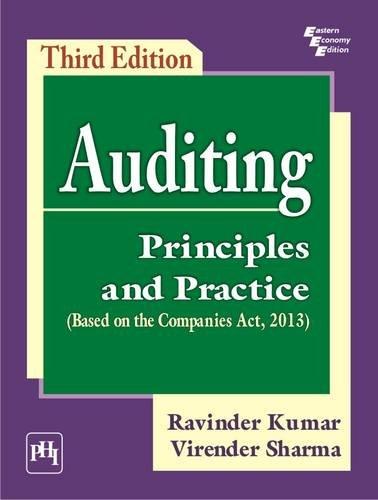Question
1) Which of the following statements is INCORRECT ? Select one: a. Trend statements help you examine patterns of financial statement line items over time.
1) Which of the following statements is INCORRECT?
Select one:
a. Trend statements help you examine patterns of financial statement line items over time.
b. The ratios that you calculate when conducting ratio analysis are defined by the FASB.
c. A Common-size balance sheet is a balance sheet with each line item expressed as % of total assets.
d. Managers need to understand financial statement analysis to understand investment, financing, operating, and reporting decisions.
2)
How do you interpret Days inventory held?
Select one:
a. The average number of days a company takes to ship inventory to retailers.
b. The average number of days a company takes to collect on accounts receivables.
c. The average number of days a company takes to sell the inventory on hand.
d. The average number of days a company takes to purchase inventory and ship it to their facilities.
3)
All else equal, what is the main concern should you have about a firm with a high debt-to-equity ratio?
Select one:
a. Will this company have an efficient system of collecting on its accounts receivables?
b. Will this company be able to pay off its debt?
c. Will this company have enough assets to operate?
d. Will this company have too many shares outstanding?
4)
Which of the following is a benefit for a company in having more debt?
Select one:
a. Shareholders have less funds to invest.
b. Shareholders benefit from a lower debt-to-equity ratio.
c. The interest payment acts as a tax shield, which means all else equal, using more debt reduces tax expenses.
d. There is no benefit to using debt.
5)
The following information is available for firm A for 2020:
| Net Sales | 10,000,000 | ||
|---|---|---|---|
| Cost of Goods Sold | 7,000,000 | ||
| Interest Expense | 200,000 | ||
| Income Tax Expense | 500,000 | ||
| Net Income | 1,000,000 | ||
| Preferred dividends | 0 | ||
| Total Assets (as of 12/31/20) | 20,000,000 | (as of 12/31/19: | 19,000,00) |
| Accounts Receivables (as of 12/31/20) | 300,000 | (as of 12/31/19: | 250,000) |
| Total Liabilities (as of 12/31/20) | 4,000,000 | (as of 12/31/19: | 3,000,000) |
| Stockholders equity (as of 12/31/20) | 16,000,000 | (as of 12/31/19: | 16,000,000) |
What is this firms ROE, ROA, and Asset Turnover? (All numbers are rounded to third decimal point)
Select one:
a. 6.25%, 10%, 0.5
b. 5%, 5%, 0.625
c. 5%, 10%, 0.625
d. 6.25%, 5%, 0.5
Step by Step Solution
There are 3 Steps involved in it
Step: 1

Get Instant Access to Expert-Tailored Solutions
See step-by-step solutions with expert insights and AI powered tools for academic success
Step: 2

Step: 3

Ace Your Homework with AI
Get the answers you need in no time with our AI-driven, step-by-step assistance
Get Started


